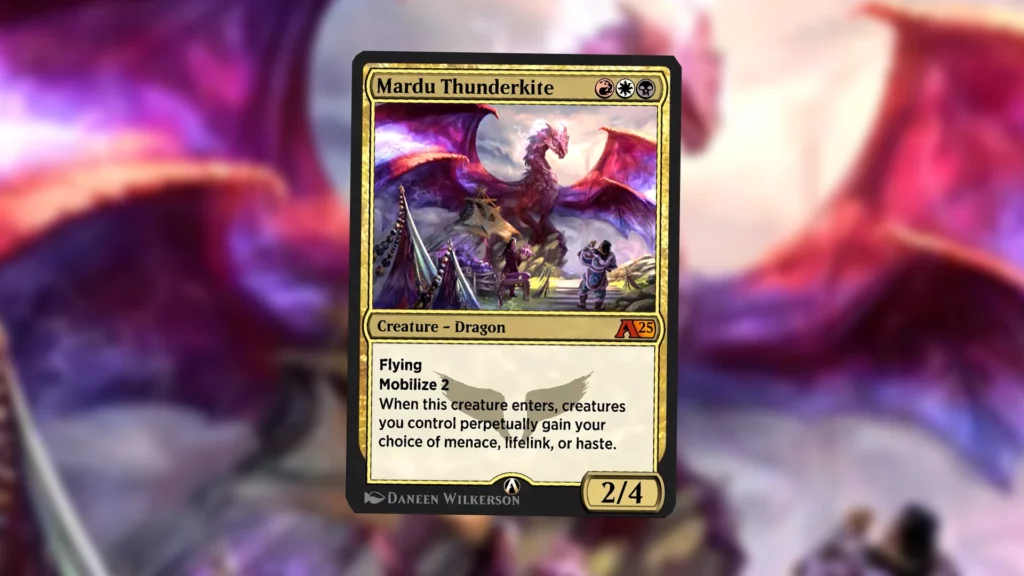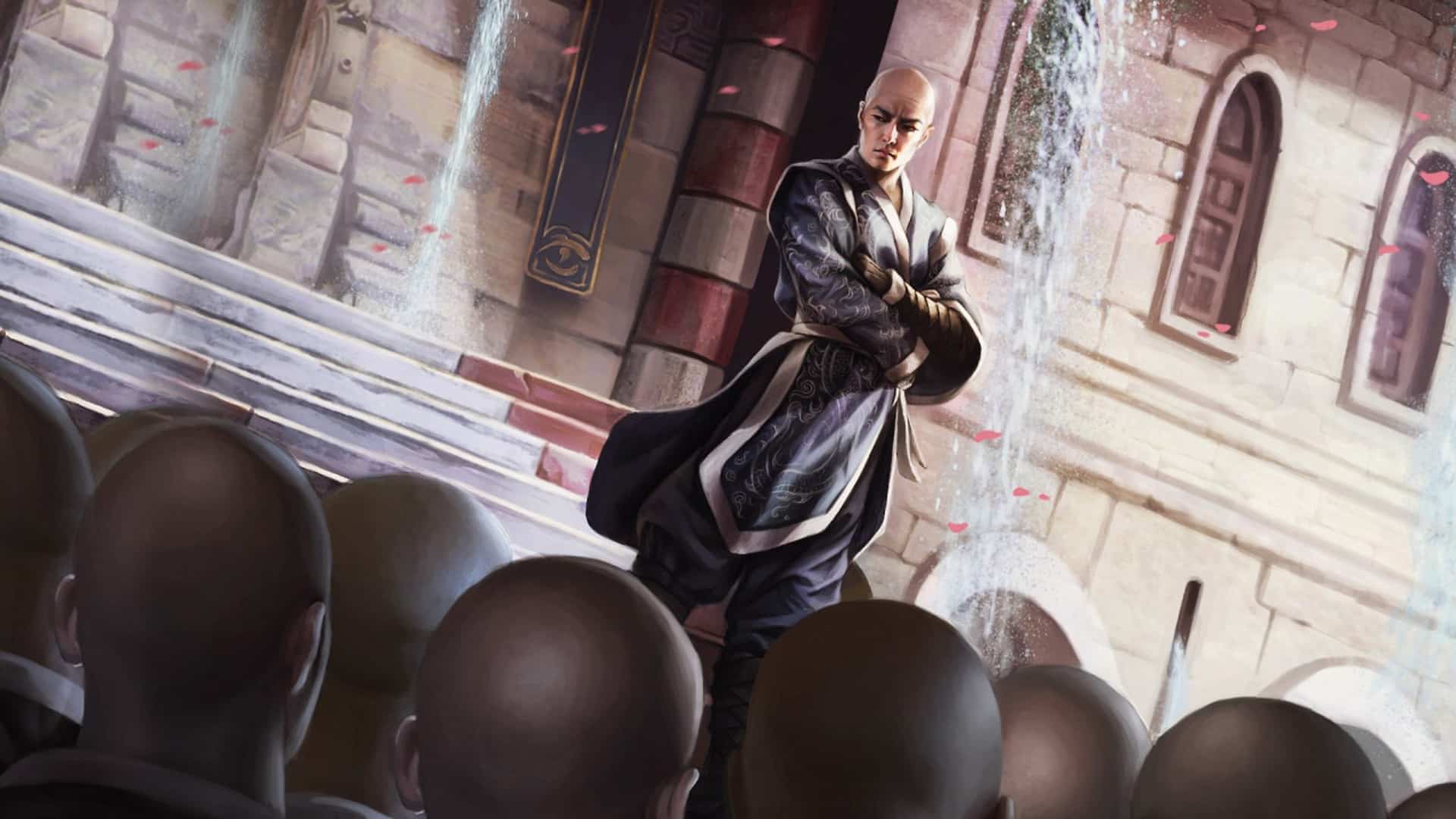The Alchemy: Tarkir spoiler season ended just as quickly as it started. After beginning this past Monday, MTG Arena finished revealing all 30 new cards today. For Pro Tour hopefuls, this release is going to be worth more than you may expect. There’s an Arena Qualifier this coming weekend, and it’s all about Alchemy.
With this in mind, there may be a mad scramble by those looking to find the latest new broken thing. There are certainly a lot of exciting cards to choose from. We’ve taken a look at a few spoilers already, but the rest of the reveals are all here.
Lam, Storm Crane Elder

Monastery Mentor may create Prowess Monks, but Lam creates Monastery Mentors. For one mana extra, this is an incredibly powerful payoff. Just cast a few noncreature spells, and you have an instant army. That being said, Lam is far from perfect thanks to their four mana cost. In a world of efficient removal, untapping with Lam in play and using the army you create will be easier said than done.
My only real issue with Lam is that it didn’t need to be an Alchemy-exclusive card. This could have easily been paper if the Monastery Mentors it created were tokens. We’ve long known this is possible in paper MTG, thanks to Garth, One-Eyed. Thankfully, proxies and Rule Zero in Commander are an option, and it’s better than not having Lam at all.
Xho Cai, Flickering Talon

In a similar vein, there is nothing stopping Xho Cai from being a paper MTG card. The only slight issue is that Xho Cai’s noncreature reduction ability doesn’t vanish at the end step, which is unusual for abilities like this. Everything else Xho Cai is perfectly fine on a paper MTG card.
Xho Cai would be a rather popular Commander, as well. Two mana for a 2/3 for Flying, Vigilance and Haste, even without the abilities, is a great rate. There’s a lot to talk about for this potential Brawl Commander. There’s so much to say, in fact, that we’ve written an article all about Xho Cai, Flickering Talon already.
Swiftspear’s Teachings

This cute nod to the iconic Monastery Swiftspear is a really bizarre card. As far as cantrips go, Swiftspear’s Teachings is incredibly efficient in an aggressive strategy. If you want to run cantrips alongside your Cori-Steel Cutters anyway, this one will be hard to beat. Outside of a deck specifically interested in running cantrips, however, this card might be a pass.
Illuminating Lash

If Illuminating Lash were an instant, it would be absolutely incredible in any deck that wants to cast lots of noncreature spells. As a Sorcery, this card is still strong. Removing a creature and, eventually, replacing itself makes Illuminating Lash strict card advantage. Better yet, Illuminating Lash can go upstairs in an aggressive Izzet Prowess list. I wouldn’t be surprised if this were a strong MTG Alchemy card.
Waystone’s Guidance

Waystone’s Guidance doesn’t necessarily create any value on its own, but it has the potential to dish out a ton of damage alongside a go-wide deck. As long as you’re consistently casting creature spells every turn, Waystone’s Guidance has the potential to dish out tons of damage. This could easily fit as an aggressive sideboard piece against slower matchups, but could just be good enough to maindeck in an aggressive strategy.
Sadly, Waystone’s Guidance is another MTG card that could have likely become a paper card with some slight adjustments.
Ureni’s Council

Ureni’s Council just seems ok. It isn’t difficult to cast this card for just one mana in the right deck, but even there, Seeking a Dragon to hand isn’t the most exciting thing in the world. Careful deck building combined with Omen creatures could make Ureni’s Council an interesting consistency piece, especially if you can Harmonize it for just two mana. Ultimately, this card will need a lot of support to be good, and I hesitate to wonder if it’s there.
On a smaller note, this card does trigger Up the Beanstalk, which does increase its utility somewhat. Still, it’s an uphill battle and likely isn’t going to see much play.
Cunning Azurescale

Yet another card that could have been a paper one with some small adjustments, Cunning Azurescale acts as a slightly more expensive, but stronger Abundant Harvest. Instead of seeking, this could have simply worked like Abundant Harvest does.
This card is a bit difficult to measure. Both of Azurescale’s modes are instant speed, which gives this promise as a control finisher. In the early game, you can use the Omen half to streamline draws. In the lategame, this is a win condition that offers card advantage. This card has potential, but it’s difficult to know for sure if it’s good enough.
Pearl Lake Warden

A lot of Dragon Brawl decks are going to get a lot of mileage out of Pearl Lake Warden. Not only do you get ahead on mana, but you can also cast it from the top of your library. Outside of Brawl, however, Pearl Lake Warden is going to struggle to see play since cost reduction, not ramp, is king in Alchemy.
Stonehide Ancient

Any Dragon Typal fans will really wish that this card wasn’t a digital exclusive. Similar to many other cards in this set, there’s no reason for this to be a digital card, either. Outside of the cost reduction not expiring at the end of turn, there’s nothing that Stonehide Ancient does that can’t be done on paper.
Once again, in somewhat of a running theme, Stonehide Ancient is likely going to be confined to Brawl. While there’s a non-zero chance that a Dragon-themed deck could become viable in Alchemy, one hasn’t appeared yet. Given that three mana is rather slow, even for a cost reduction ability, Stonehide Ancient likely isn’t going to break the meta open.
Dragonsoul Prodigy

If Dragons become viable in Alchemy, this will likely be the reason for it. Dragonsoul Prodigy turns your Omen spells into temporary bodies. This is incredibly powerful alongside strong Omen Dragons like Stonehide Ancient and Marang River Regent with game-changing enters effects. Even if the body is temporary, it’s a fantastic deal for three mana.
Filling your deck with high-value Omens that can convert into massive bodies is easy. The entire Stormbrood cycle from Tarkir: Dragonstorm synergizes fantastically with this card, but Twinmaw Stormbrood is a step above the rest. Not only will you be able to remove a creature, but you’ll gain five life and swing for five damage. I have high hopes for Dragonsoul Prodigy.
Dragonweave Tapestry

Dragonweave Tapestry offers a lot of value, but it may be too slow to matter. Four mana grants you a mana rock, a draw engine, and two cards from its Spellbook into your deck, but you won’t make an impact on the board. This seems great for a Brawl deck, but is likely too slow for anywhere else.
Dragon Typhoon

This is another splashy card that works better in Brawl than in Constructed. Dragon Typhoon is an incredible win condition should it manage to resolve and create value, but spending six mana without impacting the board is risky. You can discard this card for four mana and make a 4/4 Flying Dragon, but that’s not an amazing fallback mode in faster matchups. My bets are against this card, but it certainly has some potential, especially in decks that can reanimate enchantments.
Betor’s Edict

If you Belold a Dragon, this weird removal piece can buff the card you show off. The buff is permanent, which makes this card seem rather strong. In reality, however, three mana is a bit too slow, even for omni-removal, at least outside of Brawl. Within that format, being able to remove anything is an incredible amount of flexibility, but we’ll pass on this one for constructed.
Draconic Fealty

This is a really interesting card that we’ve never really seen before. Draconic Fealty is a great example of a card taking advantage of its digital design space. Discarding the biggest creature in a player’s hand without seeing their entire hand isn’t something you can really do in paper Magic. That said, discarding the greatest mana value card usually isn’t great in the early game, where discard spells aim to break up the opponent’s curve.
On top of this unique ability, exiling your opponent’s graveyard is always a nice bonus on top. Admittedly, it’s basically pointless early-game, but it should help it feel less pushing if you draw it late. That being said, most of the time you’ll want to keep this card in the sideboard, as it’s not really main deck material.
Mardu Thunderkite

Mardu Thunderkite is quite powerful. For three mana, you essentially get a one-time keyword buff to your board attached to a body. Thanks to having Mobilize 2 as well, Thunderkite will be punching above its weight. The only concern with this Dragon is that you need a board of creatures in play to reliably get the value worth its mana value out of it.
Currently, Mardu decks aren’t really huge in Alchemy, so Mardu Thunderkite will largely just be played in Brawl. Thankfully, building strong boards is much easier in this format, so getting good value shouldn’t be a problem at all.
Dalkovan Outrider

This card doesn’t seem strong outside of Brawl. Even in a sacrifice-themed deck, Dalkovan Outrider is just slow, since it doesn’t affect the board immediately. There’s little reason you’d combo out with this; rather than something like Blood Artist. That being said, it would be fun to massively pump up a creature and then destroy your opponent with it. Even if it does take two turns to happen…
Runeblade Raiser

Runeblade Raiser is an interesting creature, but it’s reigned in by its Perpetually clause. Since it can only return from the graveyard once, the combo potential of this card is muted at best, but that doesn’t mean it’s unplayable. Synergies in sacrifice-themed decks and with Insidious Roots will give it legs in Brawl, at least. Outside of that, however, this card doesn’t really do enough.
Hardened Bonds

A reference to Hardened Scales, Hardened Bonds is really scary inside of any archetype that can trigger it consistently in the early turns. This will allow Hardened Bonds to create a self-propelling value engine. So long as you have enough mana, you’ll never be without cards to play, so long as it sticks around. The sky is the limit for this card’s potential, provided you have a decent supporting cast.
Song of Seasons

This card might be a bit difficult to parse if you’ve not played a lot of Alchemy. Basically, you’ll Seek (randomly find) three lands that fit the various requirements. Then, you can put one in play, one in your hand, and one in the graveyard.
This is akin to a randomized Cultivate with stricter requirements for three mana. Similar to Cultivate, this will only be viable in formats where ramp is good, but cards like Cultivate do seriously help ramp become viable. This is great in Gruul Brawl decks, and could see some Alchemy play if the meta shifts.
Stormforged Armor

My issue with equipment is that it generally costs far too much to get going. Between casting and resolving the artifact, having a creature in play, and paying an equip cost, the equipment you’re using needs to be seriously strong to consider playing.
Stormforged Armor does seem a lot more viable than normal, thanks to demanding life as an equip cost instead of mana. Conjuring a Ball Lightning on attack is incredibly aggressive and can close games very quickly. If Mono Red decks return to the Alchemy metagame, this could be a strong sideboard card. In matchups with lots of spot removal, Stormforged Armor may struggle to create value. You’ll likely only want to run a few copies of this card if it is good enough.
Amber-Plate Ainok

Amber-Plate Ainok is not an impressive MTG card. If you manage to connect with this, you gain a ludicrous amount of value, but if you can’t swing in, this is just a bear. For today’s economy, this doesn’t seem impactful enough. That said, if you can connect with it, Amber-Plate Ainok is a great way to enable Hardened Bonds.
Desert Cenote

It’s an undeniable statement that MTG players going first have an advantage. There are very few formats where going second is better. It generally only comes up in Limited formats that are exceedingly slow.
Desert Cenote follows in the footsteps of Captivating Crossroads by offsetting the play/draw imbalance. Regardless of who goes first, Desert Cenote offers some pretty compelling fixing, especially for decks with more than two colors. While it’s potentially not as strong as Captivating Crossroads since its colors are determined by what’s in your hand, this land may nonetheless quickly become a staple.
Frustratingly Digital Exclusive Cards
Alchemy and Brawl fans have a lot of new interesting toys to play with, but there’s little reason for many of these cards to be digital exclusives. For better or worse, this is nothing new within the grand scheme of Alchemy, all the more so recently. That doesn’t mean that Alchemy has stolen any cards, however. Instead, each Alchemy card is purpose-built by the Arena team, so these cards are extra additions, not missed opportunities.
That being said, Wizards of the Coast could have an easy job reprinting many of these cards in a hypothetical Digital Masters set. While such a release isn’t likely at all, the possibility is nonetheless there, and many Alchemy: Tarkir cards would make great inclusion in that. Ultimately, we’ll just have to wait patiently to see if such a set will ever get made in the future.
At the end of the day, whether you like casting tons of spells, pulling off infinite combos, or ramping into some gigantic Dragons, there are lots of different cards to pick up from Alchemy: Tarkir. For eager players who want to give these cards a try, you won’t need to wait too much longer. Alchemy: Tarkir drops on April 29th.

